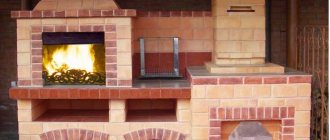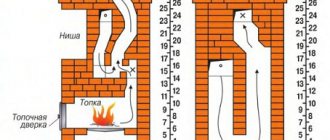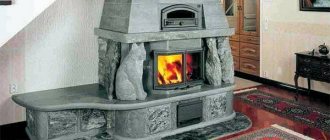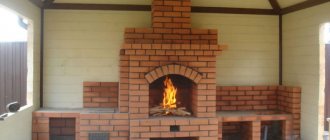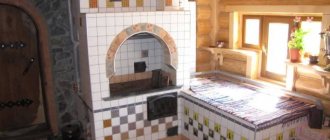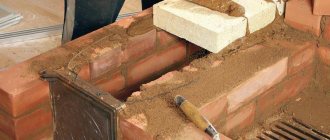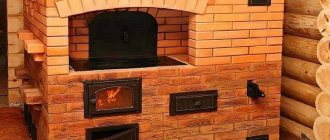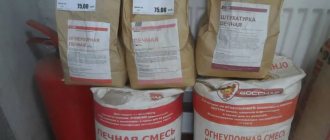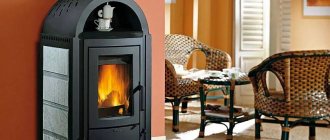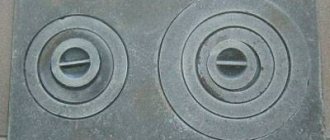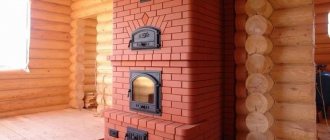Here you will learn:
- Classification of brick stoves
- Brick stove shapes for home
- Types of chimneys
- Structural elements of furnaces
- How to choose a stove for a brick house
- How to choose a place for the stove
- Features of laying a brick oven with your own hands
The history of the wood stove goes back centuries, if not millennia. In different countries, the best models have received well-deserved distribution.
Such designs are still used today, both in their classic form and with some additions.
Dutch
This design was created by Russian craftsmen. The design is not complicated and does not require much space. But this does not prevent it from giving off accumulated heat well.
Russian stove
Large-sized and multifunctional oven. But its size is justified by the presence of free space where you can relax. There is a firebox under the bed where you can cook food. Next to the firebox there is a stove, and just below there is a vent that keeps the fire going. There is also a niche for freshly prepared food.
A Russian stove can easily heat a room larger than 40 square meters. But a full-fledged robot will require a lot of raw materials.
Swede
Refer to compact options. Length and width - 1 meter . The main function is to heat the room, but you can also cook food on it. The unusual thing about such a stove is that the stove is built in the kitchen, and the rest of the stove will be in another part of the house.
This design is fire hazardous. But the risk of fire is reduced with the help of dampers.
Fireplaces and combined stoves-fireplaces
Furnace diagram
If we talk about fireplace stoves, then we immediately imagine some kind of brick building that serves as decoration for the apartment. However, a decorative fireplace and a fireplace stove are not the same thing. Considering devices associated with the word “fireplace”, we can distinguish the following varieties: decorative (artificial) fireplace, working fireplace and fireplace stove. An artificial hearth is a design element, and not a device for heating a living space. A real fireplace consists of a portal, firebox and chimney. Folding it won't be too difficult. Depending on the installation method, there are 3 main types:
- Corner fireplace . It is installed in the corner of the room. This arrangement allows you to heat several rooms at once.
- Closed fireplace . It takes up very little space as it is located in the wall of the house. The furnace is installed during the construction of the building.
- Open fireplace . Usually it is placed in the middle of the room in a large area. In this case, the chimney is suspended using special chain fastenings.
Brick fireplace stoves can have different shapes according to the chosen style. The classic version is a U-shaped design with decorative elements . D-shaped construction is typical for country style. The rectangular or semicircular hearth reflects the Art Nouveau style.
A fireplace stove is a kind of hybrid of a household stove and fireplace. The device quickly heats the room and is suitable for preparing any dishes, heating water and food, drying mushrooms and fruits. Masters of stove art offer a number of different designs that can be conveniently placed in a house of any layout (Fig. 6). In inclement weather, a brick stove-fireplace creates special comfort in the house.
Finnish stove
Finnish brick kilns got their name due to their fairly widespread use in Scandinavian countries. Their popularity in Russia is explained by the similarity of the climate and requirements for heating products. They belong to the bell type; the room is heated by heat transfer from the massive body of the stove.
The advantages of this type include:
- The ease of the device of this design;
- Light weight;
- The cost of such a model is quite budget-friendly;
- It has good heat transfer, traction and high efficiency;
- Due to the presence of a large firebox, it heats up quickly;
- A correctly folded structure is very aesthetically pleasing.
Brick oven "finka"
Drawing of a Finnish stove
The Finnish stove has a very large combustion chamber
Typically, such products are installed in the center of the room.
Classification of brick stoves
From the very name heating stoves, it becomes clear that these stoves are designed for heating premises, both residential and non-residential (garage, hangar, greenhouse, etc.).
– How are brick kilns constructed? – What types of brick kilns are there? – What are direct-flow or bell-type furnaces? What is the difference?
In this article we will consider options for heating stoves made of brick. The variety of such stoves is great and they differ primarily in the internal structure of the smoke channels.
Oven with horizontal channels
Oven with horizontal channels
In such a system, a cleaning door must be installed on each horizontal channel to remove ash and soot that settles on the horizontal surface of the channels. In such a stove, hot gases do not linger in the stove itself, but give off heat only as they move towards the chimney.
Oven with horizontal channels and heat pockets
In this furnace design, there are thermal pockets in the channels in which heat accumulates. The average cross-section of the channel along its entire length became larger, which led to a decrease in the speed of gas movement. At a lower speed of gas movement, heat transfer from hot gases to the body of the furnace itself increases. This furnace design has a higher heat capacity and, accordingly, higher efficiency.
Furnace with vertical channels
Furnace with vertical channels
Such a system of channels creates greater resistance to the movement of gases, which is both a plus and a minus of this system. The downside is that you need a higher chimney to draw gases through the stove channels. Plus, such a stove is less likely to blow out due to greater resistance in the channels. Accordingly, this system is more heat-intensive than the first option. The second drawback is overheating of the first channel, and as a consequence the occurrence of serious internal stresses. (read: cracking of the furnace body masonry).
Counterflow oven
Counterflow oven
This system differs from the system with vertical channels (version 2) in that the lower channel in it is wider. This leads to the fact that the speed of gas movement in it decreases and the heat exchange between hot gases and the walls of the furnace itself increases. This option is preferable to option 2.
Bell furnace
Bell furnace
This system is designed on the principle of free movement of gases. There are no thermal channels through which gases move, but there is a hood. Hot gases, rising to the top, cool down (giving up their heat to the stove) and go down and out into the chimney. After all the wood in the stove burns, hot gases remain in the hood and continue to give off their heat. Such a stove does not require a high chimney. Such a stove is practically not blown out. The cap or caps can be of different shapes and sizes, which allows you to make an oven of any shape and size. In bell furnaces you can use any fuel – even gas and electric heaters. Bell furnaces have higher efficiency and are more economical. This system is more profitable than options 1 2 3.
The use of combined smoke circulation systems in furnaces is allowed. There are different combinations and there are a lot of them. When designing, it is possible to combine vertical, horizontal turns and caps in different versions.
Stove with a combined smoke circulation system
As an example, a combination of horizontal channels with a counterflow system. There is also a direct flow system.
Smoke circulation of a furnace with a direct flow system
Smoke circulation of a furnace with a direct flow system and dissections
Such a system is not suitable for a heating stove, but is suitable for fireplaces, barbecues, Russian stoves and, in some cases, for sauna stoves. You can, of course, improve this scheme by adding a heat load with cuts, but still, such a system is not suitable for heating a room. Heating stoves allow the use of additional functions. Common options for such stoves:
- Heating stove with hob . Such a stove not only heats the room, but also allows you to cook or heat something on the stove. The disadvantage of this stove: low firebox, lower heat capacity of the stove itself, relatively quick cooling of the stove through the stove.
- Heating oven with bread chamber (oven) . Such a furnace has a higher heat capacity and is significantly superior to a furnace with a welding plate. There are two options for such a furnace: – continuous operation. Hot gases do not pass through the oven itself, but heat it only from below or from all sides. The so-called clean bread chamber. – periodic action. Hot gases pass through the oven, heating it from the inside. Cooking in such a stove can only be done after the wood in the firebox has completely burned.
- Heating stove with water register. This stove allows you to heat water radiators (radiators) and distribute heat throughout the room. But it is better to use a specialized furnace-boiler for this purpose.
Heating stoves can be combined. You can simultaneously install a stove and an oven, a register and an oven, etc. You can make a stove with two fireboxes. Each firebox works for its own load (which is more correct). Such heating stoves can be combined with a fireplace (open or closed). Also, such stoves can be made with a stove bench and or with a heating panel on the second floor.
There are a lot of options for heating stoves. You can always choose the oven that best meets your requirements.
Air system
Air stove heating of a house can also be made using a brick stove. The air is heated to the required temperature in a boiler or heat exchanger and supplied to the room. Passing through air ducts or entering directly into the room, hot air evenly heats the home. To transmit a larger volume of air, the chamber should be installed above the firebox. Air circulation is provided by fans or due to different densities of hot and cold air. With the help of forced circulation it is possible to regulate the temperature in the rooms.
Air heating:
Brick stove shapes for home
In addition to the specific functions, other parameters can be used to classify brick kilns.
The following types of stoves for brick houses are found in shape:
- Rectangular . It is easiest to build such structures.
- Square . They have the most compact sizes.
- Angular _ An excellent option for small spaces and rooms with complex configurations.
- Round . A very exotic and beautiful option.
- T-shaped . The most traditional type of brick stoves for the home.
The shape of the stove is usually chosen based on the specific installation location and the preferences of the home owners.
There are also varieties of home stoves based on the firebox model, where the main parameter is the wall thickness:
- Thick-walled . They are characterized by the highest efficiency.
- Thin-walled . They are equipped only with cooking types of brick stoves.
- Combined . Typically used in heating and cooking stoves for home use.
As a rule, the finished brick furnace structure is additionally finished in one way or another.
For these purposes the following can be used:
- Plaster.
- Decorative brick.
- Tiles or stove tiles.
- Special metal case.
The choice of finishing option mainly depends on the overall interior of the home and the type of brick stove. The first three options will require the use of a special heat-resistant solution based on high-quality clay. In principle, for this you can use the same mixture on which the masonry was carried out. Factory-packed dry powders are especially good in this regard: to prepare the finished solution, they must be diluted in water in the proportions indicated on the packaging. In the case of plaster, an additional reinforcing mesh made of steel is usually used, which is fixed to the brick walls. Plastering work is permitted only after the masonry has completely dried.
As for cladding with decorative bricks or tiles, only special heat-resistant samples that can withstand significant temperature fluctuations can be used for these purposes. In some cases, brick walls are left without any finishing, but for this the masonry must be done to the highest possible quality. This is also allowed in cases where there are no special requirements for the external design of the furnace. This happens, for example, if the heating structure is built somewhere in a garage, barn or greenhouse.
Buy ready-made or make it yourself
There are many different stoves on the market. Finding different variations with a water tank is easy. Wanting to save money, many try to make such a stove with their own hands. Most often these are heaters, which are supplemented with a boiler during the construction process.
- Typically, a container is built in when creating the walls of an object.
- Less common are variations with a separate design.
- When it comes to other types of structures, it is better to take a ready-made stove with a built-in water boiler.
Although the structure can be built in the form of a potbelly stove. The product is made of sheet metal; you can add brick to the structure or do without it.
Structural elements of furnaces
| Illustrations | Description of elements |
| Foundation. This structural element takes on the load from the entire structure. That is, the foundation is the base onto which the weight of the firebox, chimney and other massive and heavy parts is transferred. The foundation is placed directly on the ground and repeats the design of the foundation on which the house is built. The stove foundation is built separately from the load-bearing walls, from the foundation of the house, etc. If the wall is located nearby, a gap of 3-5 mm is maintained when building the foundation. The gap is needed so that the base under the heavy brick structure is independently movable relative to the elements in the structure of the house. | |
| Shantsy . These are the first few rows in the furnace design, starting from the foundation. The use of trenches allows you to increase the heat transfer into the room. The best option is 2-3 rows of brickwork, starting from the foundation. | |
Blower (ash chamber). This structural element performs two functions:
In order for the blower to perform the listed tasks, a door is installed in it. By opening the door to the desired width, you can control the draft. Again, accumulated ash can be removed through this door. The instructions for using the blower are simple - after the fuel has burned out, the door must be completely closed. As a result, warm air will remain in the firebox and will not go up the chimney . | |
| Firebox (firebox). A firebox is a chamber designed for burning coal, wood or other types of solid fuel. When constructing the firebox, fire-resistant fireclay bricks are used. To protect the room from sparks and hot coals, a fire door is installed at the entrance to the firebox. The traditional Russian stove is made with an open firebox, that is, it does not have a door. At the bottom of the firebox there is a grate. In the part of the firebox furthest from the door, at the top there is a hole (higho) designed to remove smoke. To prevent ash and hot coals from falling out through the open firebox door when operating the stove, in the lower part of the firebox, before installing the door, the level rises slightly so that it looks like a step . | |
| Smoke channels (smoke circulation). These elements simultaneously remove smoke from the firebox to the chimney and remove heat. In order for the smoke to give off its heat, the smoke channels are made as long as possible. As a result, the temperature at the channel inlet and outlet can differ significantly. But the arrangement of smoke circulation is planned in such a way that these channels can be cleaned from time to time from accumulated soot. Incorrectly designed smoke ducts are the reason for the stove to cool down quickly, since most of the heat goes up the chimney. Otherwise, improper design of smoke channels makes draft difficult, which also reduces heating efficiency . | |
Chimney (chimney). This element is directly connected to the smoke channels and is designed to create draft.
|
Ardenfire (META, Russia)
GC Meta specializes in the manufacture of stoves, fireboxes, linings and accessories for stove equipment.
This is a Russian manufacturer, 20 years on the market. The range of fireplace stoves we are interested in includes products made of steel and cast iron. The latter are produced in a separate Ardenfire line, in particular, models Marseille 7, 10 and 14. Despite the fact that the company is Russian, all components are supplied from abroad - only assembly and testing are carried out in the Russian Federation. Thus, cast iron parts come from France, sealing cords from Germany, glass for installation in doors from Japan. Among the features of the Marcel model: a large glass in the door with a “clean glass” system, firewood and brown coal can be used as fuel, and there is a secondary afterburning. Main characteristics of Ardenfire Marseille stoves from META
| Characteristic | Ardenfire Marseille 7 | Ardenfire Marseille 10 | Ardenfire Marseille 14 |
| power, kWt | 7 | 10 | 14 |
| Volume of heated room, m³ | 150 | 200 | 250 |
| Maximum log length, mm | 350 | 350 | 400 |
| Chimney diameter, mm | 150 | ||
| Size, mm | 364x410x800 | 415x513x977 | 439x550x1130 |
| Weight, kg | 80 | 103 | 130 |
| price, rub. | 41 250 | 60 000 | 64 000 |
Impressions from use. Powerful cast iron stoves that easily fit into the interior of a country house. Large firebox, suitable for standard size firewood. Heat from the body is transferred by radiation, so the room is not heated as quickly as in designs with convection elements. Long-term burning is not provided, but due to the massiveness of the stove, it cools down within 2-3 hours with an average burning time of 2 hours per stack. The design is simple, but the large glass area of the door gives it a special charm due to the mesmerizing view of burning logs.
View the Marcel 14 model in action:
How to choose a stove for a brick house
When choosing a brick stove for your home, you should decide on the functions it should perform. In addition to the presence of a cooking panel, it is worth noting the following criteria :
- If the stove is intended to be used as a heating device, it must be economical;
- If you decide to lay out the stove yourself, make sure that the design has a simple appearance, this will allow you to easily cope with subsequent installation;
- The oven must have a water circuit;
Many owners of country cottages prefer to install decorative stoves to give a special design to the room. In this case, the best option would be a classic Russian stove; ease of use.
Important! When choosing a brick stove for your home, you should consult a professional stove maker. He will help you choose the best option, tell you what material to use and how to lay it.
Criterias of choice
Having put together all the requirements, you will have to make a choice in favor of a specific device that can be used in the country. In order not to introduce a complex and multi-level classification of all devices, we will decide on the parameters that satisfy us.
- It is necessary to choose a device that would heat all rooms.
- This device must be equipped with a fireplace, since the presence of this addition affects the efficiency of relaxation.
- It is necessary to evaluate the performance of ready-made factory models and consider options for self-construction.
After the introduction of such restrictions, the range of available models has narrowed significantly, which will allow you to quickly determine the appropriate option.
How to choose a place for the stove
The stove can be installed in different places in the room, but its most optimal location would be to be built into the walls between adjacent rooms . In this case, with a small area of the house, you can get by with one heating structure, if the heat-transferring surface is proportional to the size of the rooms into which they open.
It is very important to correctly determine the location of the brick kiln.
It is not recommended to install the stove near the external wall of the house, as it will dry out much faster, and, in fact, it will be useless to “heat the street”.
The location chosen for construction must be carefully measured and some points taken into account:
- The height of the ceiling of the room is important, since the brick stove must fit well into the space in terms of its height.
- The foundation for the furnace must be 110÷120 mm larger than its base, and an area of suitable size must also be provided for it.
- When laid upward, the chimney pipe should not collide with the floor beams or rafters of the roof structure.
Heating water circuit
A brick stove can heat more area if, during its construction, a heat exchange structure is installed near the firebox. In it, the water is heated and begins to circulate in the heating system, which branches throughout the house. It is advisable to install a water pump that accelerates the movement of water in the system.
Fireplace with a water heating circuit: The heat exchanger pipes are led out of the stove, and a heating system is connected to them, into which water is poured. In this case, water is the coolant. Typically, plastic pipes are used to connect to the circuit.
A membrane or expansion tank is also built into the heating system. When heated, water expands and its excess flows into the tank, stretching the membrane inside it. The water cools, the pressure in the system drops, and the water returns to the circuit pipes.
Features of laying a brick oven with your own hands
What nuances do you need to know before starting to lay the stove?
- The foundation for the stove must be strong and solid. But at the same time, in no case should it be connected to the main foundation of the house. The fact is that the house shrinks over time, which is reflected in the foundation, so it is very important to separate these two elements. With seasonal soil movements and general shrinkage of the house, the design of the stove may suffer.
- The foundation should exceed the dimensions of the stove by 15-20 cm on each side. It can be made of ordinary concrete, cement mortar or made of concrete blocks.
- To lay the furnace, you need to purchase 2 types of bricks: regular solid bricks made of ceramics and fireclay (fireproof), from which the firebox, smoke ducts and all heated elements will be built. The cost of such material is much higher than the price of ordinary red brick, so it is usually used only on those surfaces that will have direct contact with fire.
- All other elements are laid from red solid brick, using a mortar based on red oven clay. The composition of such a solution must include heat-resistant cement. But between the ceramic masonry and fireclay bricks it is necessary to maintain a gap of 5 mm. As the fireclay brick heats up, it will expand. Therefore, to ensure that the furnace structure does not undergo deformation during operation, it is necessary to take this gap into account.
- All purchased elements for the stove (grid, door, hob, oven, etc.) are installed in accordance with the general layout and purpose of the stove.
Grate
- When inserting the door of the combustion chamber or ash pan, it is necessary to tie it with annealed steel wire. In this case, one end of the wire is inserted into a specially designed hole, and the second is twisted into a bundle and laid between the bricks, tightly clamped with mortar.
- When installing a cast-iron firebox or cast-iron stove, it is necessary to lay an asbestos cord between the brick and the metal element to compensate for the different temperature expansion of the materials.
- The chimney for the stove can be made of red ceramic brick, or you can use a ceramic block chimney, which is purchased ready-made.
- Cladding is the final stage of building a brick oven. To give a beautiful aesthetic appearance, the stove can be lined with red ceramic bricks, clinker bricks (like wild stone), and decorative tiles. This coating gives the stove a unique, authentic look and also protects it from the negative effects of the environment.
Steam circuit
Steam can also be used as a coolant. Many people call water heating steam, confusing one with the other, although there are differences between them. When using steam, heat transfer is higher, the room warms up much faster. In this case, the pipes are not filled with water, and their diameter is smaller than with water heating, which means cost savings. The system starts up faster, even if it has not been running for a long time.
There is also a negative side - it has a short service life. Also, steam heating is difficult to regulate; rooms are heated unevenly.
Another unpleasant moment is when pipes and radiators fill with steam, causing unpleasant noise in the system. In addition, the pipes heat up so much that you can get burned by touching them. Therefore, this heating method is recommended for use in utility rooms, garages, and warehouses.
Stove heating of a two-story house:
Cast iron with water circuit
Cast iron stoves for heating a private house with a water circuit have different capacities and are used for heating both small and large areas. Some of them are capable of heating even two- and three-story houses. The heating circuit design system is the same as for brick kilns. They are made of cast iron.
Some of them are equipped with electric heating. If the temperature in the firebox drops, the heating is automatically turned on. This function allows you to maintain the required temperature in the heating system. There are boiler stoves designed for a dual-circuit heating system, that is, in addition to heating the room, they also heat water for consumption.
Nowadays, there are still many streets and villages without gas supply, so stove heating still remains relevant and indispensable. The main thing is to have firewood in stock and keep the fire burning in the stove.
Finnish heating method:
Operating the device
After the structure is laid out, it is dried. In summer it will take 2 weeks. If the masonry was carried out in the autumn-winter period, they begin to heat the stove with small wood chips for 30 minutes once or twice a day. For additional ventilation, all cleaning doors and latches are opened (if it rains, they are not opened).
Photo 2. Finished 3 by 3 brick oven. The device is installed near the wall and has a very compact size.
When wet spots disappear from the surface and condensation stops falling on the metal elements, the structure is dry. After this, a control fire is carried out - the furnace is heated at full strength for several hours at maximum draft. If no cracks have formed in the masonry in the area of the firebox (small spiderweb cracks are acceptable), then the stove is ready for use.
Attention! You cannot immediately heat the stove too much - this will cause cracking of the masonry and render the structure unusable even before operation begins. As a result, the entire construction phase will take an average of 1 month:
As a result, the entire construction phase will take an average of 1 month:
- foundation preparation - 10 days;
- laying the stove and chimney - 1-2 days;
- drying of the structure - 14-21 days, depending on the time of year.
After this period, if no shortcomings have been identified, you can start heating the stove at full capacity.
